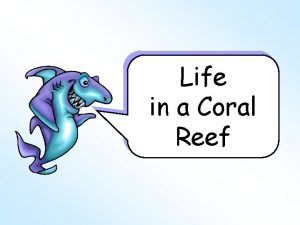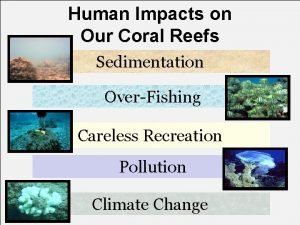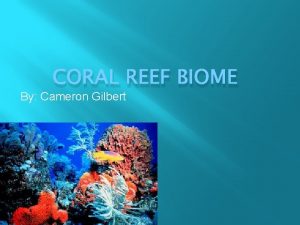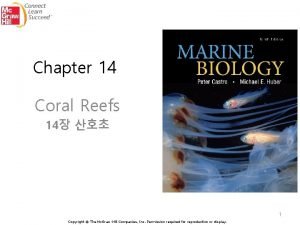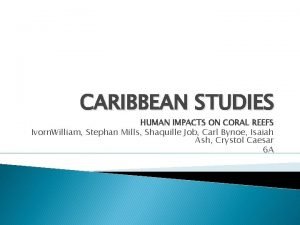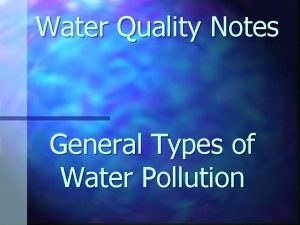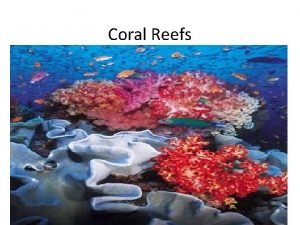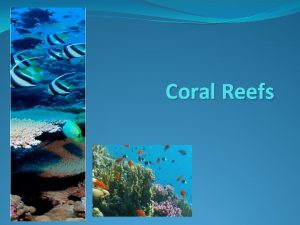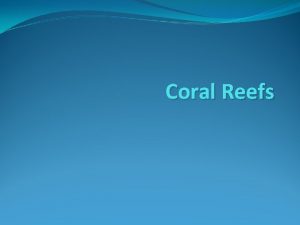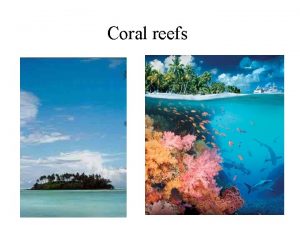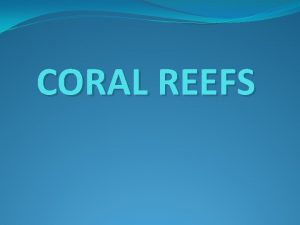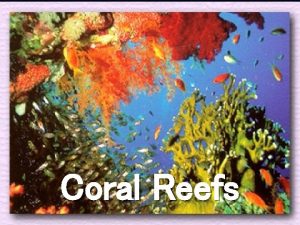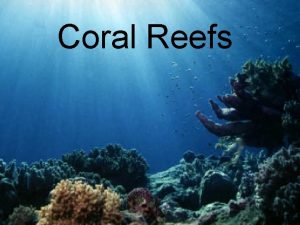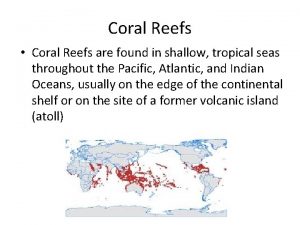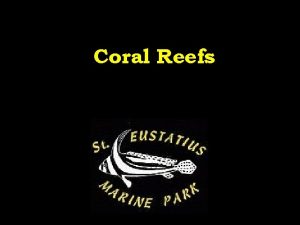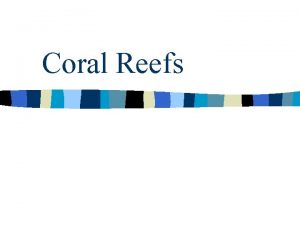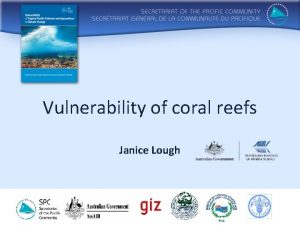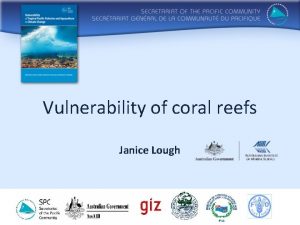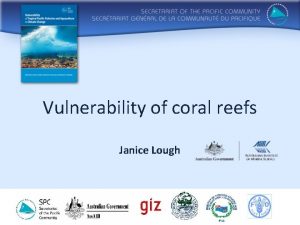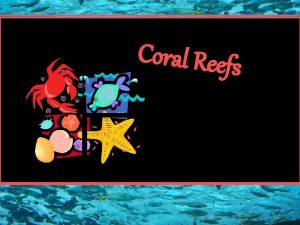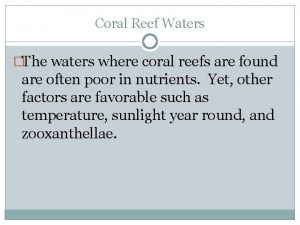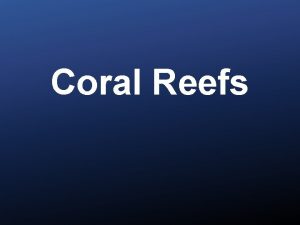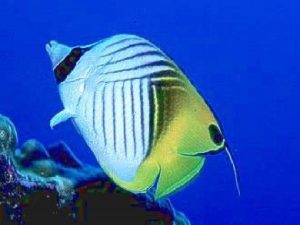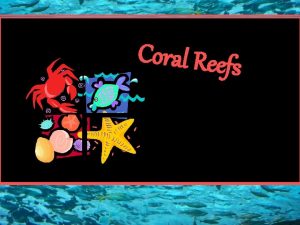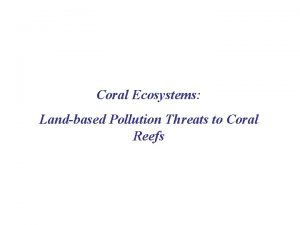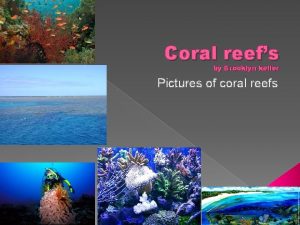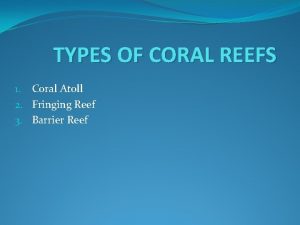Coral Reefs INTRODUCTION Coral reefs are the most





























- Slides: 29

Coral Reefs

INTRODUCTION Coral reefs are the most luxuriant and complex of all benthic communities; and they are found all around the world. The term "coral reef" generally refers to a marine ecosystem in which the main organisms are corals that house algal symbionts within their tissues. These form the largest biogenic reefs in the world. Over a vast region (millions of square miles) of the tropics, the shallow inshore waters are dominated by the formation of coral reefs, and they are often used to define the limits of the tropical marine environment.

These are the largest living structures (biogenic reef) on earth, and there are over 4, 000 species of reef fish, making coral reefs the home for one fourth of all the fish species found on the earth. Coral reefs are often referred to as ‘tropical rainforests of the sea’ Coral reefs resemble tropical rainforests in the following ways: Both thrive under nutrient-poor conditions (where nutrients are largely tied up in living matter), yet support rich communities through incredibly efficient recycling processes.

Both exhibit very high levels of species diversity. The net primary productivity of coral reefs is approximately 2, 500 grams of carbon per square meter per year, compared to 2, 200 grams of carbon per square meter per year for tropical forests and only 125 grams of carbon per square meter per year in the open ocean.

REPRODUCTION: A coral colony may consist of thousands of polyps. Polyps are typically carnivorous, feeding on small particles floating in the water. • Corals reproduce both sexually and asexually. • An entire colony many meters in diameter can start out as a single polyp. On a few nights of each year, many of the corals on the reef reproduce in an event called mass spawning.

Tens to hundreds of species of corals release their eggs and sperm into the water on the same night. The eggs float to the ocean’s surface where they can be fertilized, forming new coral larvae called planulae. The coral planulae swim in the ocean for several days to weeks until they settle on the reef bottom and grow into new corals. Corals can also reproduce asexually by budding.

During budding the coral polyp will divide to make a nearly identical copy of itself that will remain attached to the parent polyp. A coral colony will form after repeated rounds of budding and can grow to contain hundreds and even thousands of polyps. As new polyps form they overgrow older polyps that die and add their calcium carbonate skeleton to the foundation of the reef.

TYPES OF CORALS There are two main types of coral: non-reef builders (ahermatypic) reef builders (hermatypic). • Ahermatypic corals, such as soft corals and solitary hard corals, and they do not form reefs as they do not possess the symbiotic algae, Zooxanthellae in its internal body wall. • . Hermatypic corals are reef forming corals and this is possible for them because they are known to harbour Zooxanthellae in their body wall. These are hard corals that form large colonies from thousands of connected polyps living together, sharing food and energy.

Major types of coral reefs There are three major types of reefs: 1. fringing reefs, 2. barrier reefs 3. atolls.

Fringing reefs extend along the shoreline, close to land or separated only by a narrow stretch of water, but that can extend out to sea long distances. This reef type exists in shallow waters. Barrier reefs form farther offshore, usually 10 -100 kilometres from the coast, and often form massive walls of coral separated from the coast by a large channel or lagoon. Atolls are circular reefs surrounding a lagoon that form when volcanic islands sink into the ocean over millions of years

DISTRIBUTION OF CORAL REEFS Coral reefs occur throughout the tropical region The most diverse region of the world for coral reefs is centered on the Australia, Philippines, Indonesia, Malaysia and Papua New Guinea, with between 500 - 600 species of corals. The total area of coral reef in India is estimated to be about 2, 375 km 2 which is less than 1 % of all the coral reef areas in the world.

The mainland coast of India has two widely separated areas containing reefs, the Gulf of Kachcch and Gulf of Mannar The Andaman and Nicobar Islands in Bay of Bengal have fringing reefs around many islands, and a long barrier reef (329 km) on the west coast

FACTORS LIMITING THE DISTRIBUTION OF CORAL REEFS • Coral reefs are sensitive to even for a slight change in the environment. • Wide varieties of environmental factors are known to influence the distribution of coral reefs. • There are six major physical factors that limit coral reef development and distribution viz. , temperature, depth, light, salinity, sedimentation, exposure to air, etc.

1. Temperature • Reef-building corals tend to live in shallow waters that border islands or continental shelves within the latitudes of 32° 30’ N to 32° S, where waters are warmer. • They grow in warm waters that range in temperatures from 18 - 36°C (64 to 97° F). • The ideal temperature range for these corals is 25 -29°C (77 to 84° F). • Reef development does not occur in waters where the annual mean minimum temperature drop below 18°C. • Optimal reef development occurs in waters where the mean annual temperatures are about 23 - 25º C.

2. Depth • Coral reefs are also limited by depth. They do not develop in water that is deeper than about 50 -70 m. • Most reefs grow in depths of 25 m or less. • This is evidenced by the fact that these structures are restricted to the margin of continents or islands. • The reason for the depth restriction has to do with the light requirement of Zooxanthellae, living together with hermatypic corals.

3. Light • Light is one of the most important factors limiting coral reefs. • • Reef-building corals contain symbiotic algae (Zooxanthellae) in its tissue, and for these algae sufficient light must be available for carrying out photosynthesis. • Without sufficient light, these algae cannot survive and this leads to the death of the corals. • Even if the water is shallow and warm, coral cannot survive if those waters are loaded with sediments as this blocks critical sunlight from penetrating far below the surface.

4. Salinity • It is an important factor that restricts coral reef development. • Hermatypic corals are true marine organisms and are intolerant of salinities deviating significantly from that of normal seawater (32 - 35 ppt). • Wherever inshore waters are subject to continuing influxes of freshwater from river discharge so that the salinity is lowered, reef will be absent. • However, on the other hand, coral reefs do occur in regions of elevated salinity, such as the Persian Gulf, where reefs flourish at 42 ppt.

5. Sedimentation • Sediment suspended in the water, settle out on the coral reefs, has an adverse effect on the corals. • Many corals can remove limited amounts of sediment by trapping it in mucus and carrying it off by ciliary action. • Most hermatypic corals, however, cannot withstand heavy sedimentation, which overpowers their ciliary-mucus cleansing mechanism, clogs their feeding structures, and smothers them. • Sediment in the water (turbidity) also reduces the light necessary for photosynthesis by the Zooxanthellae in the coral tissue. As a result, coral reef development is reduced or eliminated in areas of high turbidity

6. Wave action • In general, coral reef development is greater in areas subject to strong wave action. • Coral colonies with their dense, massive skeletons of calcium carbonate are very resistant to damage by wave action. • At the same time, the wave action provides a constant source of fresh, oxygenated seawater and prevents sediment from settling on the colony. • Wave action is also responsible for renewing the plankton, which is food for the coral colony.

7. Exposure to air • Finally, coral reefs are limited in an upward direction by emergence into air. • Though abundant secretion of mucus may prevent dehydration for a short time, by exposure to air for an hour or two, most corals are killed by such long exposure.

8. Nutrient loading and contaminant inputs • Addition of nutrients to the water may harm corals directly or make the environment less favourable for reefs by promoting growth of phytoplankton and of seaweeds (macro algae) that compete with corals for space on the reef. • Additional organic production resulting from nutrient loading can also increase populations of bioeroders that break down coral skeletons and reef structures. • Unlike nutrients, contaminants are generally humanproduced toxic materials, which include heavy metals, pesticides and herbicides, solvents, fuels, and other compounds.

ANIMALS ASSOCIATED WITH CORAL REEFS • Coral reefs provide habitats for a large variety of organisms. • Some organisms that use corals through mutualism, commensalism and parasitism are within the taxonomic groups Porifera, Polychaeta, Mollusca, Crustacea, Echinodermata and Pisces (butterfly fishes – Chaetodontidae, puffer fishes – Tetraodontidae, parrotfishes – Scaridae etc. ). • Sponges (Porifera) are found inhabiting cavities in the reef. These sponges, such as Cliona, cause bio erosion in corals. .

• Polychaetes such as Hermodice carunculata and Gastropods in the family Trochidae depend on corals for food. • The giant clam (Bivalvia), Tridacna sp commonly occur in coral reef areas. They feed on corals such as Porites and Agaricia. • Decapod crustaceans such as shrimps and crabs depend on corals for shelter. Xantid crabs form cavities in the coral Acropora palmata.

Echinoderm such as Acanthaster planci ( this is a starfish, commonly called as crown-of-thorns) are coral’s top most predator, which feeds exclusively on coral polyp and devastate the entire reef areas if swarming of this predatory star fish occurs. There are many other species of fungi, sponges, sea worms, crustaceans and molluscs that bore into coral skeletons. Other organisms that inhabit the coral reefs include variety of fin fishes, sea urchins, jellyfish, oysters, clams, turtles, and sea anemones.

THREATS TO CORALS 1. Destructive fishing practices: These include cyanide fishing, blast or dynamite fishing, bottom trawling, and banging on the reef with sticks. Bottom-trawling is one of the greatest threats to cold-water coral reefs. 2. Overfishing: This affects the ecological balance of coral reef communities, warping the food chain and causing effects far beyond the directly overfished population. 3. Careless tourism: Careless boating, diving, snorkeling, and fishing happens around the world, with people touching reefs, stirring up sediment, collecting coral, and dropping anchors on reefs

4. Pollution: Urban and industrial waste, sewage, agrochemicals, and oil pollution are poisoning reefs. • These toxins are dumped directly into the ocean or carried by river systems from sources upstream. Some pollutants, such as sewage and runoff from farming, increase the level of nitrogen in seawater, causing an overgrowth of algae, which 'smothers' reefs by cutting off their sunlight. 5. Sedimentation: Erosion caused by construction (both along coasts and inland), mining, logging, and farming is leading to increased sediment in rivers. • This ends up in the ocean, where it can 'smother' corals by depriving them of the light needed to survive. The destruction of mangrove forests, which normally trap large

6. Coral mining: Live coral is removed from reefs for use as bricks, road-fill, or cement for new buildings. • Corals are also sold as souvenirs to tourists and to exporters who don't know or don't care about the longer term damage done, and harvested for the live rock trade. 7. Climate change: Corals cannot survive if the water temperature is too high. • Global warming has already led to increased levels of coral bleaching, and this is predicted to increase in frequency and severity in the coming decades. • worldwide integrated approach to prevent global warming is the immediate need for the protection of coral reefs

CONSERVATION AND MANAGEMENT MEASURES The world has woken up to the magnitude of the problem and has taken steps to halt the degradation of one of the richest ecosystems. The Convention on International Trade in Endangered Species of Wild Fauna and Flora, or CITES, has classified many corals as threatened species. The establishment of marine sanctuaries or reserves may help ensure the protection of this ecosystem in the years to come. In addition, more focused actions should be taken to protect, conserve and manage these valuable resources

The following are the measures to be under taken on an integrated basis: • Creation of awareness and environmental education • Need to provide alternative/additional livelihood options • Community based reef ecosystem protection and management • Coral reef restoration and rehabilitation • Enforcement mechanism • Baseline data • Need for long-term reef monitoring • Sea ranching for enhancement of stock • Marine biodiversity data management
 Insidan region jh
Insidan region jh Omnivores in coral reefs
Omnivores in coral reefs Does overfishing affect coral reefs
Does overfishing affect coral reefs Coral reefs biomes
Coral reefs biomes Competition in coral reefs
Competition in coral reefs Coral notes
Coral notes What is the last step in the formation of an atoll?
What is the last step in the formation of an atoll? Coral reefs caribbean studies
Coral reefs caribbean studies Detailed lesson plan about coral reefs
Detailed lesson plan about coral reefs Coral y falso coral diferencias
Coral y falso coral diferencias Type of reefs
Type of reefs Hát kết hợp bộ gõ cơ thể
Hát kết hợp bộ gõ cơ thể Slidetodoc
Slidetodoc Bổ thể
Bổ thể Tỉ lệ cơ thể trẻ em
Tỉ lệ cơ thể trẻ em Voi kéo gỗ như thế nào
Voi kéo gỗ như thế nào Thang điểm glasgow
Thang điểm glasgow Hát lên người ơi alleluia
Hát lên người ơi alleluia Các môn thể thao bắt đầu bằng tiếng bóng
Các môn thể thao bắt đầu bằng tiếng bóng Thế nào là hệ số cao nhất
Thế nào là hệ số cao nhất Các châu lục và đại dương trên thế giới
Các châu lục và đại dương trên thế giới Cong thức tính động năng
Cong thức tính động năng Trời xanh đây là của chúng ta thể thơ
Trời xanh đây là của chúng ta thể thơ Mật thư tọa độ 5x5
Mật thư tọa độ 5x5 Làm thế nào để 102-1=99
Làm thế nào để 102-1=99 Phản ứng thế ankan
Phản ứng thế ankan Các châu lục và đại dương trên thế giới
Các châu lục và đại dương trên thế giới Thơ thất ngôn tứ tuyệt đường luật
Thơ thất ngôn tứ tuyệt đường luật Quá trình desamine hóa có thể tạo ra
Quá trình desamine hóa có thể tạo ra Một số thể thơ truyền thống
Một số thể thơ truyền thống

